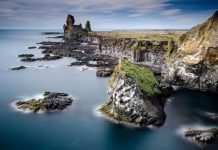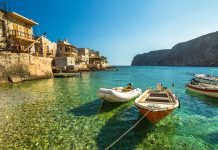If you believe the roadside posters on the deserted roads east of the Ikhlara Valley, a trip without visiting Guzelyurt cannot be considered a trip to Cappadocia. The slogan may seem overly optimistic, but stone houses are piled up on the slope, roosters are crowing and cows are mooing in the alleys, all roads gradually lead down into the valley, where numerous remains of rock churches have been preserved. Rounded mountains, a monastery by the lake, the silhouette of Mount Hassan on the horizon, the unhurried flow of life make up a pleasant respite from the hustle and bustle, and this is one of the main pleasures of rural Cappadocia.
In Ottoman times, the town was known as Karbala, until the population exchange in 1924, about 1,000 families of Ottoman Greeks and 50 families of Muslim Turks lived here. After the events, the Helver Greeks moved to Nea Karvali in Greece, and Turkish families from Kozan and Kastoria in Greece moved here. Relations between the two countries are now celebrated with the annual Turkish-Greek Friendship Festival held in July.
Attractions
Monastic Valley
From the central square of Guzelyurt, follow the signs to the right and further down the street about 400 m to the ticket office. There is an underground city to the right of the ticket office. The restored complex occupies several levels, there is a creepy place in it where you have to squeeze through a hole in the floor. There is also a small, not too interesting satellite of the underground city about 100 m back along the road.
Right behind the ticket office you will see the impressive facade of the Buyuk Kilise Jami. It was built in 385 AD as the Church of St. Gregory the Theologian, restored in 1835 and turned into a mosque after the population exchange in 1924. St. Gregory grew up in these parts and became a theologian, patriarch and one of the four fathers of the Greek Orthodox Church. Inspect the wooden pulpit of the preacher – rumor has it that it is a gift from the Russian tsar. Inside, everything is very simple, but there are plans to reveal the frescoes, now closed with whitewash.
Then you can continue along the Monastery Valley, which stretches for 4.5 km, resembling the Ikhlara Valley in miniature. There are plenty of panoramic viewpoints here, and it’s nice to just walk through the valley, but along the way you will also meet rock churches and settlements worthy of study. Located about two kilometers from the previous stop, Kal-burluki has a forest and a spectacular portal. Almost adjacent to it, the Kemurlu kilesi is interesting with stone carvings, including exquisitely worked architrave, in addition, there are several Maltese crosses in it.
Juksek Church and Monastery
High on the rock dominating Lake Guzelyurt, about two kilometers south of the turn sign on the road to Ikhlara and one kilometer west of Guzelyurt are the Juksek Church and the ruins of the monastery. There, the road makes its way between huge boulders balancing on other rocks, like hypertrophied sculptures in an art gallery. On the fenced territory there is an uncomplicated church and monastery, heavily painted with graffiti from the inside. From a distance they look more impressive than up close, but from here there are wide views of the lake and mountains.
Kyzyl kilise
Against the background of fertile fields, the red masonry of the Kyzyl Kilis church can be seen for miles. This one of the oldest churches in Cappadocia was in the process of restoration during our visit. It is located 8 km from Guzelyurt, on the road to Nowhere, just after the village of Serrykhisar.










